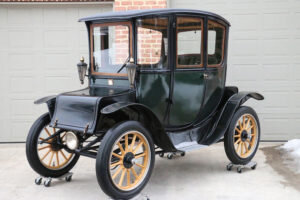Horseless Vehicles Part One
Horseless Vehicles Part 1: Frances Woodworth Ball’s Electric Car
Electric cars are not a new concept. Manufacturers were producing electric-powered cars in the late 1800’s as an alternative to gasoline powered engines. Like other early cars, many small companies built their own versions. Each claimed that the batteries they used were the most efficient and would last 60, 80, or 100 miles before recharging.
Initially marketed to upper-class women for driving around town, there were many reasons to own an electric vehicle. They were easy to start and drive, ran cleaner than a gas engine and had no odor, faster than a horse-drawn conveyance and were quiet so horses were not spooked, pneumatic tires provided a smooth ride, and the “fuel” was cheap and readily available. They were also more convenient than steam powered cars which required filling and firing the boiler and then waiting for the pressure to build up. Unfortunately, the batteries were not as reliable as advertised which is why the early electrics did not gain in popularity with the masses and eventually just faded out as gasoline-powered vehicle technology continued to improve.
Charging the car was relatively easy. Owners usually had charging stations installed at their residences similar to the one pictured below. In larger metropolitan areas there were public charging stations like we see now or one kept their car stored at a garage outfitted with multiple charging stations and then called for it when needed.
Several of the Ball family women had their own electrics. Elizabeth (Bessie) Brady Ball, Bertha Crosley Ball, and Ball cousin Mary Lincoln all had electric cars and here Frances Woodworth Ball is pictured in hers.
Because the image is a small, blurred, undated snapshot it is difficult to see many details of this “top hat” or brougham style car and therefore make a definite identification of the model or manufacturer. Several aspects, however, point to it probably being a Baker Electric made in Cleveland, Ohio:
Eight windows including the full front window. (An option was two stacked window panels as seen below, the top of which could be opened.)
Small side panel sections in front of the doors
Front hood battery box size and curved shape
Door handle placement to the front
Center mounted front headlamp on the frame
Flat roof and extended overhang
Shape and depth of fenders and integrated running boards; fenders are equally curved over the wheels on each end and do not flare upwards
Two other electrics of the time had similar features, the Fritchle, built in Colorado, and the Buffalo/Babcock built in Buffalo, NY. The Fritchle, especially the 1915 model, had similar fenders, battery box, and center headlamp. The roofline of the Fritchle has an obvious curve with no overhang above the front window while the Baker roof is essentially flat and has the overhang.
Fritchle Colonial Coupe 1915
The Buffalo Electric (merged with Babcock in 1915) also has features similar to the Baker: flat roof and overhang, door handle placement, battery box, and fender depth. However, none of the advertising shows a center headlamp, the fender shape is different in the rear, and most models did not have the side panel section in front of the door. Because Frances and her family were from Buffalo it would seem natural that she might have owned one these but not enough of the features match.
Another possible clue that her car was a Baker is an advertisement that ran in the Muncie Evening Press in August 1910. The Machine Electric Supply Company on North Mulberry Street were dealers of Baker Electrics so it seems reasonable that she would have purchased the car from a local source. The family may also have seen them displayed at the first New York auto show in 1900 or at the Buffalo Pan American Exposition the following year where Baker won a silver medal.
Regardless of the manufacturer, these electric vehicles were definitely ahead of their time. It has taken almost a hundred years to recreate similar clean, efficient technology that is finally becoming more viable as an alternative to fuel engines.





